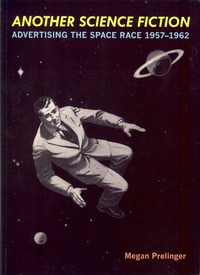Review: Another Science Fictionby Eve Lichtgarn
|
| Prelinger and Blast Books have produced a work with solid footing in both graphic arts and space history. Her text is thoroughly researched, entertainingly anecdotal, and excellently footnoted. |
Author Megan Prelinger captures this rarified convergence of the right brain with the left brain in her remarkable new book titled Another Science Fiction, which is beautifully packaged by Blast Books. Recruitment ads from vintage issues of Aviation Week, Missiles and Rockets and Fortune magazines are meticulously reprinted. Prelinger defines a specific five-year period as the golden era of such advertising. This is bracketed by the seminal 1957 Soviet launch of Sputnik and 1962, the first fiscal year that NASA’s human spaceflight program budget and hiring spree began to plateau.
Another Science Fiction shows us the symbolic imagery of ads from such industry powerhouses as Douglas, Rocketdyne, Lockheed, Thiokol, and Hughes, as well as the quaint and obscure, such as Temco, American Latex, Marquardt, Ex-Cell-O, and Radiation Inc. Some of the most surprising examples emanate from the Los Alamos Scientific Laboratory. Prelinger explains that LASL commissioned prominent regional artists in New Mexico to create a series of paintings for its recruitment campaign starting around 1959. These works of abstract expressionist modernism are simply breathtaking.
It may have been tempting for the author and publisher to issue Another Science Fiction exclusively as an art book, and, with such a rich source of visuals, it would stand alone as such. However, Prelinger and Blast Books have produced a work with solid footing in both graphic arts and space history. Prelinger is a professional archivist and her text is thoroughly researched, entertainingly anecdotal, and excellently footnoted.
A great deal was riding on these advertisements for all the sponsoring entities. Their purpose was threefold: 1) To attract the best and the brightest among the engineering and scientific communities; 2) To carve out a specialty in the complicated chain of space hardware production and stake the territory from competing subcontractors, and; 3) To send a message to NASA brass that purchase orders could be fulfilled. The language utilized is energetically optimistic. An electrical insulation manufacturer promised, “With Continental-Diamond Fibre can-do, your products will be better than ever. Drop us a line to start the ball rolling.” Bendix announced, “Opportunities are open to better engineers and scientists interested in participating in advanced space programs in an ideal scientific climate.” Martin offered, “Unique opportunities to engineers and scientists who want to advance in the professional fields as rapidly as their capabilities permit. Perhaps you should do it now. Just write to N.M. Pagan, Director of Technical and Scientific Staffing.” A manufacturer of foamed plastics exudes, “The Stafoam orbit is infinite! Your investigation may uncover an entirely new dimension. Write or call today!”
The title page spread is itself worth the price of admission to this book. It is a detail of an ad by Texas Instruments that appeared in the December 1957 issue of Fortune. A cowboy riding the range witnesses a rocket blasting off from the chaparral just a stone’s throw away. His started horse is wild eyed. In one hand, the cowboy has a coil of barbed fencing wire, a symbol of the taming of the western frontier. In his shirt pocket is a pencil, a symbol of the taming of the scientific frontier. This is the perfect image to underscore the fusing of science fact with science fiction.
